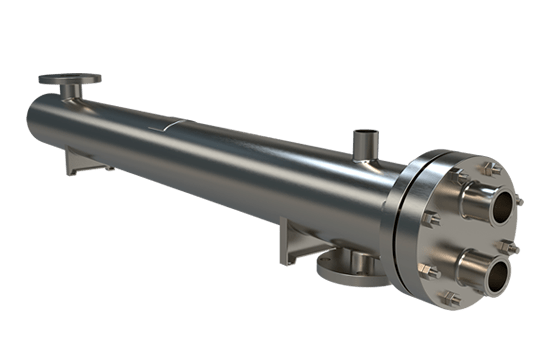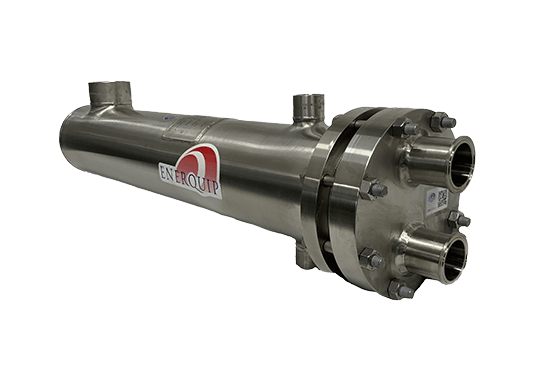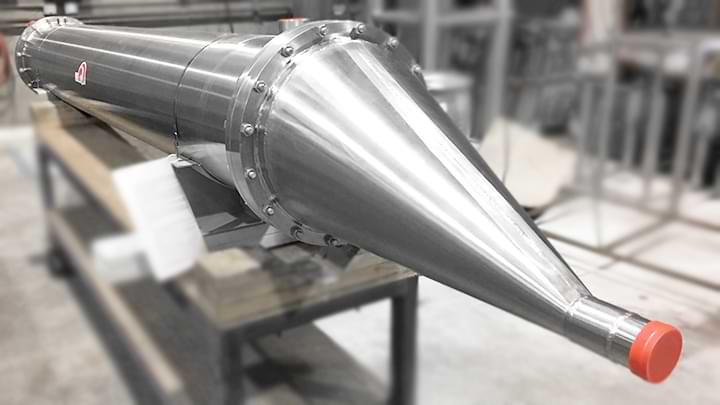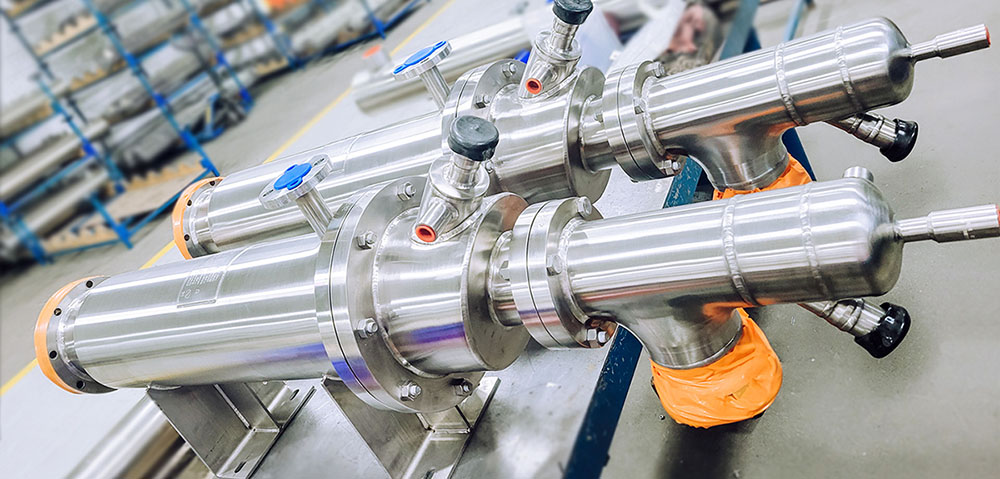Sanitary SS Exchangers
These heat exchangers typically consist of an array of tubes housed within a shell. One fluid flows through the tubes, while the other fluid moves around the tubes inside the shell, enabling effective heat transfer. The design of sanitary shell and tube heat exchangers emphasizes smooth surfaces and minimal crevices to reduce bacterial growth and simplify cleaning. They often feature complete drainage capabilities and are constructed from high-purity materials that can withstand both aggressive cleaning procedures and high-temperature processes.
Stock Units
Sanitary Applications
- Evaporators & Condensors
- Clean-in-Place
- Bio-Tech

Custom Units
Sanitary Applications
- Brewery & Distillery
- Food & Beverage
- Dairy Pasteurization

Sanitary Processing
These types of heat exchangers are common in the dairy industry:
- Shell and Tube Heat Exchangers are vital in sanitary processes, ensuring efficient heat transfer across various stages of production while maintaining cleanliness standards.
- Sanitary Heat Exchangers are crucial in optimizing production, enabling the recycling of thermal energy and supporting phase changes in process fluids under hygienic conditions.
- Waste Heat Economizers enhance energy efficiency by capturing residual heat from operations, repurposing it to reduce overall energy consumption and operational costs in sanitary environments.
- Thermal Fluid Heaters are designed to circulate heat within closed systems, providing consistent and controlled thermal energy for sanitary processing applications.
- Sanitary Bare Coil Tank Heaters offer precise temperature control for tanks, ensuring that process fluids remain within the desired thermal range while meeting sanitary requirements.
- Bayonet Heaters immerse directly into tank fluids, providing effective and sanitary heating solutions for maintaining process fluid temperatures.
- Steam Generators deliver an efficient alternative for on-site steam production, tailored for sanitary processes where large-scale boilers are not feasible.

Sanitary Stainless Steel Heat Exchangers
These heat exchangers are used in a variety of applications, including pasteurization, sterilization, temperature control during fermentation, and cooling products before packaging. Their primary function is to maintain the desired temperature and ensure consistent quality throughout the production process. Instead of a one-size-fits-all approach, these heat exchangers are often tailored to specific applications, considering factors such as flow rate, fluid viscosity, and temperature requirements to meet the precise demands of each industrial process.
Benefits of Sanitary Shell and Tube Heat Exchangers
Sanitary shell and tube heat exchangers offer a variety of customizable forms, making them an adaptable solution for numerous applications. Their flexibility in size and configuration allows them to fit diverse needs, all while delivering significant advantages. One of the primary benefits is their compact spatial footprint, which not only optimizes space on the production floor but also minimizes the risk of heat pockets that could potentially damage other electrical components. Additionally, these heat exchangers are environmentally friendly, as they are designed to operate continuously without relying on additional equipment, resulting in lower energy consumption compared to other temperature control methods. This efficiency contributes to another key advantage: reduced operating costs. With less need for supplementary equipment, these heat exchangers are inherently more economical to maintain and operate.

Further advantages of using sanitary shell and tube heat exchangers include their ability to process fiber or particulate products, handle high working pressures and temperatures, allow for straightforward inspection and disassembly, ensure high security in aseptic processes, and offer easy customization to meet specific needs.
Capabilities of Our Sanitary Shell and Tube Heat Exchangers
Our company has specialized in the production of sanitary and industrial heat exchangers since 1985, with all our equipment fabricated in the United States. This domestic production ensures reliability and mitigates concerns about unstable overseas supply chains. Despite our local manufacturing, our high-quality standards have helped us establish a global client base.
We adhere to the rigorous standards set by the Tubular Exchanger Manufacturers Association (TEMA), ensuring that our sanitary shell and tube heat exchangers offer excellent consistency and long-term reliability. Depending on the application and customization, our products meet TEMA classes B, C, and R.
Furthermore, we are among the few manufacturers certified to build heat exchangers that comply with the 3-A Sanitary Standard, enabling us to serve clients in the food and dairy industries. Our collaboration with 3-A inspectors guarantees that all our designs and fabrication practices adhere to these stringent standards, ensuring that our sanitary heat exchangers pass inspections without issues.

We also lead in the supply of Clean-in-Place (CIP) sanitary shell and tube heat exchangers in the US. Understanding the urgency of some client needs, we offer off-the-shelf products available in various sizes for greater compatibility. When custom solutions are required, our team of engineers and designers is ready to provide tailored support, ensuring that every client's specific sanitary heat exchanger needs are fully addressed.
Additional Upgrades
We offer a range of upgrades to enhance existing sanitary shell and tube heat exchangers. These upgrades include cladding and insulation with stainless steel jackets, mounting saddle supports, adjustments to connections and baffles in liquid applications, modifications to meet the 3-A Sanitary Standard, passivation or electro-polishing of contact surfaces, material upgrades (such as Duplex, Hastelloy, 316L SS, AL6XN, and other alloys), multiple pass designs, and the addition of bonnets to improve tube side velocity in tight spaces.


